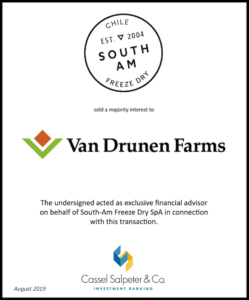Archive for year: 2019
Van Drunen Farms and SouthAm Freeze Dry Announce New Business Partnership
Van Drunen Farms, with headquarters in Momence, IL, is a world leader in agriculture, food science, and dehydrating fruits, vegetables, and grains. SouthAm is a trusted freeze-dried fruit supplier to many global CPG companies and is widely known as a leader in delivering the highest quality freeze-dried ingredients. Its headquarters are just outside of Chile’s capital, Santiago. The company enjoys strong competitive advantages that come from its ability to leverage direct, local access to the rich farming output of Chile and the South American supply chain. SouthAm combines a local focus with an international reach.
“This partnership will better position both SouthAm and Van Drunen Farms, offering unique and substantial benefits for our customers,” remarked Kevin Van Drunen, Co-Owner and President of Van Drunen Farms, and Board Member of SouthAm. “It is exciting to see our global platform expanded with a partner that shares our long term vision to be a global leader in freeze-dry ingredients and has a truly international reach.”
The investment in SouthAm provides Van Drunen Farms, including its dietary supplement powerhouse FutureCeuticals, a key competitive advantage for South and Central American fruits in the food, functional food, and supplement spaces, as well as continues SouthAm’s innovation, which is focused on the development of native herbal, fruit, and vegetable ingredients. The partnership allows both organizations to enhance their access to global supply, which benefits each of their respective customer bases.
“We are thrilled to take this next step as a company,” added Boris Hirmas Said, founder and Chairman of the Board of SouthAm. “We started in 2004 with a mission to create a world-class business to showcase Chile’s unique capacity for premium quality manufacturing and food products. With that initial goal achieved, we are now ready to partner with Van Drunen Farms to bring this message and these products to the world. It is truly a win for us, for our Van Drunenpartners, and above all for our customers. Ultimately, with our combined resources we have now broadened our direct supply chain to both hemispheres, making us both more efficient and effective.”
“What is truly unique about this partnership, and something that is very important to us at Van Drunen Farms, is that both SouthAm and Van Drunen Farms are family owned companies,” remarked Jeff Van Drunen, Co-Owner of Van Drunen Farms, President of FutureCeuticals, and Vice Chairman of the Board of SouthAm. “Once all of the due diligence and pro forma is complete, it’s these kinds of intangibles that transform a project from a fine idea that makes good financial sense into something intrinsically great for everyone involved. Culture and values matter to us, and SouthAm aligns perfectly with who we are as people, a family, and as a corporate entity.”
Cassel Salpeter & Co. served as exclusive financial advisor to SouthAm. The team was led by Chairman James S. Casseland Director Philip Cassel.
“It is a rare occurrence for a partnership to come together with two parties that share such deep-rooted values within their organizations,” said James Cassel. “We believe that Van Drunen Farms and SouthAm, with their similar long-term approach, will create a strong foundation for success well into the future. It was a pleasure to play an important part in facilitating the combination of these two great companies.”
About SouthAm Freeze Dry
SouthAm fuses creativity and innovation with world-class quality standards. SouthAm takes a holistic approach to business; handling everything from sourcing and manufacturing of freeze dried food solutions to custom tailored product development.
About Van Drunen Holdings
The Van Drunen Family of Companies is a global presence in the food, functional food, and nutraceutical industries. Van Drunen Farms, founded in 1856, is a global leader in the growing of culinary herbs, as well as the dehydration of fruit, vegetable, grain, and herbal food ingredients. VDF FutureCeuticals, Inc. is a vertically integrated functional food ingredient, product development, and bioanalytical research and discovery company serving the supplement and functional food industries with patented and clinically-researched functional ingredients. VDF Europe operates an expanding freeze drying facility in Serbia serving the EU, the near East, and Asia. Golden State Herbs is an agricultural and air drying operation located in Thermal, California. Van Drunen Specialty Seeds, a non-gmo seed development company currently focused on proprietary basil seed varietals, operates in Thermal, California.
About Cassel Salpeter & Co.
Cassel Salpeter & Co., LLC is an independent investment banking firm that provides advice to middle market and emerging growth companies in the U.S. and worldwide. Together, the firm’s professionals have more than 50 years of experience providing private and public companies with a broad spectrum of investment banking and financial advisory services, including: mergers and acquisitions, equity and debt capital raises. Co-founded by James Cassel and Scott Salpeter, the firm’s headquarters are in Miami.
SOURCE Van Drunen Farms; FutureCeuticals, Inc.
Related Links
5 things you should never cut corners on when growing a successful business
By James S. Cassel

When Wendy’s founder Dave Thomas was asked why his company’s burgers were square, he replied, “Because we never cut corners.” Thomas’ grandmother Minnie reportedly instilled this value in him, and his reply is a reminder that with some aspects of your business, you can’t afford to cut corners. Reducing effective marketing, customer service, employee benefits, and cybersecurity, or not nurturing your company’s core DNA, will cost you.
A study by marketing service OutboundEngine found that a staggering 50 percent of business owners admit to not having a marketing plan. It reports 55 percent of owners of small and medium-sized businesses (SMBs) spend less than 5 percent of annual revenue on marketing, and over 58 percent of SMB owners spent just five hours a week or less on marketing.
If the study is accurate, these companies are heading down a slippery slope. Keeping your company top-of-mind is fundamental to success and growth. Resources spent on strategic marketing is money you should get back with a healthy return.
Too often when times get tough, owners make ill-advised cuts to marketing/PR/ad budgets because they don’t understand the importance of these fundamental tools for stabilizing or growing a company. A business’ future viability requires not just cost controls, but revenue enhancement. Ill- advised slashing, or not putting in the time, effort or resources to successfully market your company will slowly deplete your business.
Remember not to under- or overspend, but work with your team to get your message out effectively.
Now, take a moment to consider the last time you reached out to a company and think about that customer service experience. Was it easy to find someone to handle your problem? Did the company resolve the matter quickly? If you’re a smart consumer and the answer was “no,” you likely moved on to another company to get that product/service.
Companies like Amazon and Lexus consistently rank as top customer service providers. Look to their efficiencies and strategies as a road map to your company’s customer service success. This is your front line of defense against bad-word-of-mouth and negative reviews online. Whether you’re building a culture of customer service, choosing the right vendor to handle inbound calls, or selecting digital customer service providers, in today’s era, with a negative review just a few clicks away, customer service is more important than ever.
Another area to support is your team, maybe your most important asset. If you hope to recruit and retain the top talent, potential and current employees need to know you’re willing to invest in them. Everything from company retreats, education, vacation time, and other benefits, matter.
Securing employee buy-in is directly correlated to how much you value your team, and how you treat your employees may ultimately affect how they deal with your clients and customers. If you have underappreciated employees, you’ll be faced with costly turnovers, problematic recruiting, or discover your employees are unwilling to deliver the level of service essential to your success. Little things matter when it comes to building esprit de corps. Don’t skimp here.
Underneath everything your company does, there should be a recognizable identity. Remember your mission and never forget your principles. You must know what your core DNA is, then you need to build and nurture that. And, if your company is growing, but its identity is being diluted, you have a problem. It’s time to regroup to ensure that the one good thing you are known for, is the one thing that never changes.
Finally, highly publicized trade secrets thefts and the Equifax and Capital One data breaches show there are malicious actors out there looking to target you next. Skimping on adequate cybersecurity measures to safeguard your customer data, trade secrets and intellectual property will end up costing you customers, while saddling your outfit with financial liability and huge image problems. All this can mean the death of your business.
Every company owner is faced with the task that only ends when the business ends: Ensuring that your operation is lean and efficient. But as you’re trimming costs, remember not to be pennywise and pound-foolish. There are certain things your business just can’t afford to do without.
James S. Cassel is co-founder and chairman of Cassel Salpeter & Co. jcassel@casselsalpeter.com.
South-Am sold a majority interest to Van Drunen Farms
- Background: South-Am Freeze Dry SpA (“South-Am”), founded in 2004 and based in Chile, is a full-service manufacturer of premium freeze-dried fruits, vegetables, and powders, driven by top standards of food safety and traceability. South-Am fuses creativity and innovation with world-class quality standards.
- Cassel Salpeter:
- Served as financial advisor to the Company
- Distressed operations with excess plant capacity and negative cash flow
- Spin-out of a non-core business unit
- Challenges:
- Niche industry with a limited number of potential buyers
- Expedited timeline to close
- Spin-out of a non-core business unit
- Outcome: On August 14, 2019, Van Drunen Farms (“VDF”) acquired a majority interest in South-Am. VDF is a world leader in agriculture, food science, and dehydrating fruits, vegetables, and grains.
- The partnership formed between South-Am and VDF provided South-Am with a significant minority stake, and quickly filled excess plant capacity, providing a path to profitability.
Is It Too Late to Change Your Business Structure?
By Kiely Kuligowski
Your business structure is the cornerstone of your company. It is likely one of the first things you decided on when you created your business and, since then, has guided many of your business decisions.
- It is possible to change your business structure at any point.
- A change in structure requires careful consideration, planning and
consultation from professionals and colleagues. - Make sure you are aware of all the ramifications of switching and not switching before finalizing your decision.
Your business structure (LLC, S-Corp, C-Corp, etc.) determines the level of control you have over your company, the taxes you pay and how your business operates day-to-day. When you are in the early stages of launching your business, choosing a business structure can feel like a permanent decision, considering everything it determines. However, just like life, things change. Industries grow and shrink, perhaps you want to minimize your tax liabilities, or you may even want to reduce your exposure to potential liability. It is possible to change your business structure to better suit your changing business needs.
Types of business structures
To change your business structure, you must first know what type of business you are changing to. There are four main business structure options:
- Sole proprietorship
- Partnership
- Limited liability company (LLC)
- Corporation
Many small companies start as a sole proprietorship, which is the simplest and most common way to start a business, according to the U.S. Small Business Association. A sole proprietorship is an unincorporated business owned and run by one individual who is entitled to all profits and responsible for all business debts, losses, and liabilities.
Another structure is a partnership, which can be as simple or as complex as the business owners make it. You may have an oral “handshake deal” or a written partnership agreement that outlines the basis for the partnership, business expectations, liabilities, etc. A business partnership can have two or more business partners; however, more partners can mean more complications in making business decisions.
A Limited Liability Company (LLC) allows you to take advantage of the benefits of both a corporation and a partnership. LLCs offer greater protection from personal liability in most cases by sheltering your personal assets, such as your vehicle, house, or savings accounts, if your LLC runs into bankruptcy or lawsuits. Profits and losses flow through to your personal income without facing corporate taxes, though, but LLC members are considered self- employed and must pay self-employment taxes.
A corporation is a company or group of people that are authorized to act and legally recognized as a single entity that is separate from its owners. Corporations come in two types: C-Corps and S-Corps. C corporations are subject to double taxation, where the company is taxed before and after the distribution of dividends. S corporations are the most common corporate structure for small businesses largely due to the exemption from double taxation. Corporations also offer the largest degree of protection from personal liability but are costly to form and require extensive record-keeping.
When to change your business structure
“It is 100% possible and [often] a good idea for some business owners to change the business structure,” said Matthew Meehan, CEO of Shield Advisory Group. But be sure that you are doing so for the right reasons.
A common motivation for changing business structure is taxes, whether that’s saving or simplifying tax filing, or to increase your legal protections as a business owner. Many businesses also change their structure when undergoing significant changes, like hiring, or seeking outside investment or financing.
“More often than not, a business will decide to change its structure because the needs of the business are changing and you are beginning to outgrow your existing structure,” said Deborah Sweeney, CEO of MyCorporation and business.com community member. [Are you writing a business plan? You may find business plan software helpful. Check out our reviews and best picks.]
Consider a change when you see clear evidence of opportunities that you cannot capitalize on due to your current structure, said Martin Calvert, marketing director at GreyClaw Marketing. “Changing the structure of a business can be highly effective, but there will be inevitable disruption, so knowing why this change is required is key,” he added.
Another reason for a change in structure, particularly for sole proprietors, is greater business credibility. Many customers will take a business more seriously if it has a strong, flexible legal structure.
If you are questioning if a change is necessary, sit down and review your reasons for wanting the change, how it benefits the company, potential drawbacks to making the change, and what is required of you (and the business) to make it happen.
Consult a professional during this process – most experts agree it is not something that should be done on your own.
“When changing your company structure, you must talk to your tax advisors, because you want to avoid unnecessarily triggering a tax event,” said James Cassel, chairman and co-founder of Cassel Salpeter & Co. “You have to talk to both your tax lawyers and your accountants so you fully understand what the ramifications of the change might be.”
How to change your business structure
The first thing you should do is check with your secretary of state and a tax advisor about regulations regarding businesses to see what steps and paperwork is required. Make sure that that you know what new licenses, insurance or registration the new structure will need, if any. Your tax advisors can guide you through this process.
Then inform all of your employees – if any – what the change will be, how it will be implemented, and what the short- and long-term effects will be.
Charles Floate, founder and CEO of DFY Links, advised that any structural changes be implemented slowly.
“The change should be staggered,” he said. “Otherwise, flipping the business structure upside down in one fell swoop can make things twice as bad.” Floate encouraged making the most important changes first and allowing them to settle before moving on to secondary changes to ensure a smooth transition for everyone. [See related article: How to Change Your Business Structure]
What not to do
There are many things to be aware of when changing your business structure. And because it is your own business, you have a strong personal stake in ensuring that you steer clear of legal and/or financial trouble. As such, do not change your business structure on your own. Consult experts outside of your company, as well as partners and/or employees.
“A structural change to a company should never be done a whim,” said Calvert. “Or due to ego or the personal opinion of one individual, even if that individual is the CEO.”
By consulting numerous individuals both within and outside of your company, added Calvert, you are more likely to understand the implications of inaction and the outcomes you realistically hope to achieve by changing your structure.
Cassel said that the most common mistake he sees with businesses altering their structure is choosing the wrong type of entity for tax purposes.
“You [also] have to be very careful when you are restructuring for tax purposes. Sometimes if you change the entity but later want to change it back, you may encounter limiting factors and even potential penalties,” he said.
Be confident in your change and why you are making it, and have evidence that it will push the company forward.
Here are key business issues that presidential candidates must address
By James S. Cassel

With the 2020 election fast approaching, presidential hopefuls set on wooing business owners need to devise a courtship strategy based on more than platitudes. Given that many entrepreneurs are supportive of various Trump economic policies, and according to some polls, from a financial standpoint, feel he has their “best interests at heart,” candidates must address foundational issues — including taxes, regulation, labor, tariffs, the environment, healthcare, and income inequality — while remembering that this is still a capitalist democracy, not a socialist country.
First, although many business owners cheered President Donald Trump’s tax reform, there remains a sense that middle-market businesses benefited little, while big business and the wealthy were its main beneficiaries.
Candidates should define their plan for equitable taxes and which temporary breaks they would make permanent. It’s also important to remember the economic effect of both tax increases and tax breaks on the deficit, which recently hit a record $22 trillion and is still growing. This also needs to be balanced against social needs.
Regulation is another important issue. Under this administration, deregulation is driven by the requirement to eliminate two regulations for every new one added.
Business owners are generally supportive of deregulation as it can substantially impact their bottom line. Candidates should reassure business owners that under their leadership, government would be responsive, reasonable, and committed to eliminating red tape, while keeping in mind that many regulations are in the public’s best interest and end up saving money in the long term. For example, many states and companies do not want a rollback of auto emission standards due to the negative effects on climate, and ultimately, the economy.
Another key issue involves labor. Trump’s anti-immigration policies worry many business sectors, including agriculture, construction, and restaurant and hospitality, which rely on this labor.
Candidates should adopt level-headed approaches to this sensitive issue, neither avoiding it, nor demonizing immigrants — who are part of the ever- changing tapestry of this country and grow our economy. Without immigration, we would not have the same GDP growth.
Also, burdensome tariffs (ultimately a tax paid by consumers); a current, if fragile, truce in the U.S.-China trade war; and the looming threat of more tariffs, are part of the new reality for entrepreneurs, manufacturers, and farmers. Given how tariffs affect the supply chain, impacting the U.S. and global economies, candidates must develop a clearly articulated policy aimed at defusing tensions with China and other nations, while not ignoring trade problems and the transfer/theft of intellectual property.
Another issue, the environment, is a sore spot for green-minded business owners who decry Trump’s environmental record — including pulling out of the Paris Climate Accord and undermining the Clean Power Plan.
The environment has economic and global repercussions: It impacts insurance rates for businesses, can shut down supply chains, increases food costs, drives mass migration, and is not a matter that can be kicked down the road anymore. With the environment, a stalemate that continues to stagnate results in disaster for generations to come.
A sixth area is healthcare. While the administration has made clear its intention to repeal Obamacare, its proposed solution remains elusive, and we have yet to see what the courts will do. Uncertainty is a death knell for business owners.
Finally, presidential hopefuls should consider that increasing income for lower earners translates into more buying power and a stimulated economy. The current federal minimum wage is $7.25. Despite Trump’s campaign promises, it has not been increased in 10 years, although many companies have raised wages out of necessity to secure employees.
It is not sustainable to have to provide taxpayer-funded assistance in the form of food stamps and other benefits to those who are working 40-hour weeks, but still can’t make ends meet.
Thoughtfully fleshing out issues that matter to business owners will enable presidential hopefuls to stand out and gain support. These are tough issues, but they cannot be ignored by either the administration or candidates. In the political arena, where blustering, posturing, and unbridled contention are the modus operandi, a moderate, cool and balanced voice of reason could be an irresistible magnet around which America rallies.
James S. Cassel is a monthly contributor to Business Monday of the Miami Herald who writes about issues affecting the middle market; the views expressed are his and not necessarily those of the newspaper. Cassel is co- founder and chairman of Cassel Salpeter & Co., an investment-banking firm based in Miami.
Achaogen sold the global assets to Cipla USA
- Background: Achaogen, Inc. (“Achaogen”), based in South San Francisco, CA, is a biopharmaceutical company that develops and commercializes innovative antibacterial agents to address multidrug-resistant gram-negative infections.
- Cassel Salpeter:
- Served as financial advisor to the Company
- Conducted a robust sales process, identifying and contacting approximately 200 strategic and financial parties
- Significantly increased the value of the opening bid by running a competitive auction
- Provided assistance throughout all phases of the Chapter 11 Section 363 sales process, due diligence, and auctions
- Challenges:
- Achaogen’s lead asset, ZEMDRI™, had an unsuccessful launch which lead to massive layoffs, including almost all Achaogen’s sales force
- Dramatic downturn in the availability of financing from both the debt and equity markets for companies in the anti-infective field
- Maximizing value with no stalking horse bidder in place
- Outcome: On July 23, 2019, the court approved the sale of Achaogen’s core assets to Cipla USA Inc., a subsidiary of the India-based parent, Cipla Limited. Additional assets were also sold to multiple buyers as part of the bankruptcy sales process.
How Might Rising Gas Prices Affect Your Business?
Elevated fuel costs are affecting everything from manufacturing to employee commutes. Learn how these business owners are offsetting rising gas prices.
By Julie Bawden-Davis
With rising gas prices currently sweeping across much of the U.S., there’s a good chance that your company will experience the effects in one way or another. Rising gas prices have a trickle-down effect on the price of many goods and services in a wide variety of industries.
“When fuel costs rise, producers tend to increase their sale prices,” says Brian McHugh, owner of McHugh Construction. He and his crew use half-ton or larger trucks that burn a significant amount of fuel.
“Our margins are better than businesses like retail, so we don’t currently have to raise our prices. If the increase gets dramatic enough, we would consider wrapping those expenses into the final sale price,” says McHugh. “In order to stay profitable, businesses with lower margins and price points are finding it necessary to increase prices or establish better purchasing terms.”
Effect of Rising Gas Prices
Michael Black is president of Goliath Trucking, a long-haul trucking company. Rising gas prices have had a profound effect on his business.
“Since our company is a direct consumer of high volumes of fuel, rising gas prices have caused a need for increased operating capital,” says Black. “The additional cash required to operate adds up quickly.”
It’s hard for businesses to escape the effects of rising gas prices, adds James Cassel, chairman and co-founder of investment banking firm Cassel Salpeter & Co.
“If your company produces or uses petroleum-based products, such as plastic, costs will increase,” Cassel says. “Freight costs will also rise as many carriers add a fuel surcharge.”
Rising gas prices also make it more difficult for employees to commute to work, believes Robert Sadow, co-founder and CEO of Scoop. (The company works with businesses to create managed carpool programs.)
“Your employees have the onus of finding alternative, more affordable methods of transportation,” Sadow says.
Kamil Faizi, owner of Challenge Coins 4 U, which creates custom military challenge coins, agrees.
“Commuting eats into employee paychecks, which can affect your company’s bottom line,” says Faizi. “You may need to pay employees more to offset rising fuel costs.”
Rising Gas Prices Lead to Increased Operational Costs
As fuel prices increase, it’s likely your business will have to absorb the added costs.
“Many companies will need to compensate for rising fuel costs by raising prices, especially if the increased gas prices continue,” says Hanna.
Increasing costs to the consumer will be necessary for Black.
“The margins in the trucking industry are too tight and competitive to take on the added fuel cost,” he says. “Increases must be passed along on the freight bill, which ultimately leads to the consumer paying more for products.”
To minimize the cost of rising gas prices, here are several countermeasures you may want to use at your company.
Adopt a work-from-home program.
At Challenge Coins 4 U, rather than spend more on employee compensation to offset rising gas prices, the company implemented a work-from-home program two days a week.
“As a way of handling rising gas prices and employee commutes, we allow employees to complete their work at home,” says Faizi. “As long as their work is being completed in a timely manner, there is no problem. I have found this to be an effective strategy that has never let me down.”
Start a managed carpool program.
“Managed carpool programs help consumers save on gas costs and offer the added benefit of improving employee-to-employee relationships and limiting employee attrition,” says Sadow of Scoop. “For instance, carpools can introduce people who ordinarily might not interact at work, which creates an increased sense of community in the office.”
Sadow suggests implementing an employee carpool system to offset rising gas prices sooner than later.
“Get something going as soon as possible so that the program can grow and scale,” he says. “It’s much better to add people to an existing program than to build one from scratch when you have hundreds of employees.”
If you don’t have many employees interested in carpooling, Sadow suggests pairing up with companies in your area.
“If a handful of companies get together and implement a solution across their organizations versus simply their own, they’ll better use existing resources and won’t compete for parking,” he says.
Examine fuel efficiency.
If your business involves transportation, you can help minimize the effects of rising gas prices by taking a close look at the various elements that affect fuel efficiency.
For instance, consider streamlining routing and dispatch. The shorter the routes and better informed the drivers, the less fuel your company vehicles will use. Dispatchers that track traffic in real-time can reroute drivers for better fuel efficiency.
“Ensure that the route is planned in the most efficient way possible and that the trucks are packed full for shipping,” says David Lecko, CEO of DealMachine, an app for real estate investors interested in off-market properties. His company uses drivers who report potential properties.
Other factors that affect fuel efficiency include vehicle speed, how often and for how long a vehicle idles and how well-maintained the vehicle is. Regular maintenance can improve fuel efficiency.
Plan ahead.
“Proactively manage the risk of rising gas prices by taking into consideration the effect of price changes during the budgeting process,” says Hanna. “When developing budgets, complete sensitivity analyses to identify how changes in key inputs or outputs impact the bottom line.
“Use these analyses to develop action plans,” continues Hanna. “By proactively developing a plan, business owners will be better equipped to manage fuel increases and other changes that might impact their bottom lines.”
It’s also possible to offset rising prices by increasing the purchase of products or raw materials now that are used by your company, believes Cassel.
“Try to hedge or buy futures, if available,” he says.

Get In Touch
Cassel Salpeter & Co.
801 Brickell Avenue,
Suite 1900
Miami, FL 33131
(305) 438-7700
Stay Informed
Sign up today for insights and growth strategies.
Subscribe Now







